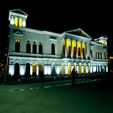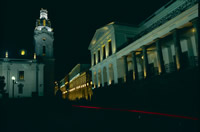 |
History Lies
in the Capital
Quito, the provincial of Pichincha and the nation’s capital,
is the departure point for Ecuador’s main tourist destinations.
Due to its strategic location and well developed tourist infrastructure
Quito is an ideal place from which to start a trip and a great place
to hold both national and international conventions and other events.
The city lies at the foot of the western Andes range and enjoys
a spring-like climate, with temperatures ranging from 13 to 24 degrees
centigrade. Its Mariscal Sucre Airport, is one of Ecuador’s
international terminals.
Apart from its historical capital, Pichincha has an abundance of
interesting destination: protected areas with extensive forests
and towering volcanoes, archaeological sites, and villages indigenous
markets that sell the finest in artisan crafts.
TOP
Quito -
Cultural Heritage of Humanity
 |
Situated in an Andean valley at
2,850 m above sea level at the foot of Volcano Pichincha (4,794
m), Quito is a modern city with a living history. One of Latin America’s
most historically important cities, Quito has been declared a Cultural
Heritage of Humanity site by UNESCO. Noteworthy for its architectural
beauty, Quito is home to numerous churches and convents built in
the colonial period. The Metropolitan Cathedral, located in Independence
Plaza, is one of the city’s most impressive historical and
architectural sites. Others worthy of mention are the following
cathedrals and historical sites: San Francisco, la Compañía
de Jesús, San Agustín, Santo Domingo, El Sagrario,
La Merced, Carmen Bajo, San Sebastian, Santa Barbara, and San Blas.
A large part of their interiors, especially the altars and pulpits,
are gilded in gold and house innumerable works of religious art.
Some of their museums hold valuable collections of paintings and
sculptures belonging to the artistic genre which has been come to
known as the Quito School.
Another important building is the Carondelet Palace, the seat of
the Central Government. In Quito’s historical center, with
its steep, narrow, cobblestone streets, the artistic and architectural
influence of Spain can be seen in the general architectural style
of the homes, their balconies, their tiled roofs, and their interior
patios. Another colonial area, outside the of Old Town, is the suburb
Guápulo. Perched on the eastern slopes of the city, Guapalo’s
most impressive sight is its famous sanctuary to the Virgin of Guápulo,
the oldest sanctuary of its kind in the country.
However, despite its rich living history, Ecuador’s capital
is at the same time a modern metropolis with a variety of hotel
facilities to chose from, including many of the world’s major
hotel chains. Quito also has countless restaurants (serving national
and international cuisine, alike), shopping centers, theaters, convention
centers, and everything else that the most demanding tourist could
possible need.
The city has its annual festival in December, when festivities such
as bullfights, the election of the Queen of Quito, national and
international concerts, street dances, and fireworks turn Quito
into the site of a national gala for an entire week. The celebrations
are in honor of founding of Quito on December 6, 1534 by Sebástian
de Benalcázar.
TOP
Cayambe-Coca
Ecological Reserve
Covering over 400,000 hectares in area the Cayambe-Coca Ecological
Reserve is located in the provinces of Pichincha, Imbabura, and
Sucumbíos. Its main attraction is the snowcapped peak of
Cayambe. Towering 5,790 m above sea level, Cayambe attracts mountaineering
buffs from all over the globe. Those not bent on climbing to the
dizzying altitudes of Cayambe flock to the Reserve to hike around
its many lakes and through its vast forests. Moreover, the hot springs
of Papallacta, which lie at the park’s entrance just two hours
from Quito, are another very popular destination, especially on
weekends.
TOP
Mindo-Nambillo
Forest Reserve - A Unique Nature Refuge
Mindo, situated approximately 2
hours northwest of Quito, is the country’s most important nature
reserve for bird watching. Roughly 500 species of birds can be found
in this cloud forest.. The area also is home to humid semitropical,
primary, and secondary forests. In the midst of all this exuberant
flora, a variety of mammals, reptiles, and brightly colored butterflies
also thrive. Moreover, the area’s rivers and waterfalls provide
a beautiful backdrop and limitless opportunities for water sports.
TOP
Pasochoa
Forest Reserve
Located just an hour from Quito, Pasachoa Forest Reserve is popular
destination for tourists and nature lovers. This 1,000 acre Reserve
is the habitat of a large number of birds and mammals. Home to roughly
120 kinds of birds, the Reserve's forests are filled with the songs
of such species as blackbirds, plateros, and turtledoves.
Rich in vegetation, trees such as the pumamaqui and the alder
cover the Reserve's hillsides, which can be climbed by all types
of nature enthusiasts on guided and self-guided paths. Pasachoa
has a souvenir shop, a museum, and a campsite.
TOP
Culture
& Traditions
Throughout Pichincha, highland villagers celebrate traditional,
religious, and pagan festivals. On May 2nd, the Lord of Good Hope
is celebrated in Checa. In June, the Middle of the World, Cayambe,
and Sangolqu? hold the Maize and Tourism Festival. San Pedro and
San Pablo festivities are held in Cayambe, Pomasqu?, and Tabacundo
on July 29th. On September 24th, Quito pays homage to the Virgin
of La Merced and the La Fiesta de la Virgen is celebrated
in El Quinche on November 21st when mass pilgrimages to El Quinche,
one of the country's major religious sanctuaries, are made by the
nation's faithful. In March and April, Easter celebrations are held
all over the country, the most impressive of which being Quito's
Good Friday (or Jes?s del Gran Poder) processions.
TOP
La Mitad
del Mundo - Where the Planet is Divided
The village of La Mitad del Mundo (Middle of the World) is
just 20 minutes outside of Quito. This tourist complex, constructed
to mark the equator's passage through the nation, is a typical Andean
village. On one side of the village's plaza, and featuring as one
of the main buildings, is the Equator Monument, with a lookout point
at the top. The structure houses an anthropological museum which
showcases artifacts collected from all over the country. Around
it there are other attractions such as a small planetarium and a
model of colonial Quito. There is also a walkway lined with the
busts of the scientists who took part in the Geodesic Mission which
came to Ecuador to measure the meridian arc dividing the world into
two hemispheres. Each of the nationalities of the members of this
mission is represented by their own pavilion.
TOP
Cayambe
Cayambe is 45 minutes north of Quito. This quiet village, famous
for its milk and biscuit production, is the gateway to the snowcapped
mountain of the same name. One of its traditions is the celebration
of the San Pedro and San Pablo festival in June.
TOP
Calder?n
Calderón, just 15 minutes from the capital, is known for
its baked bread products. These small, soft, brightly colored treats,
depicting typical Ecuadorian characters and other themes, are as
attractive as they are delicious and are sold throughout the town.
TOP
Sangolqu?
and Conocoto
These two small towns, located just south of Quito in the Chillos
Valley, are often frequented on weekends for their local dishes.
Outdoor markets sell typical food such as potato cakes, roast pork,
and chicha (a maize-based alcoholic drink).
TOP
Cochasqu?
North of Quito lies the ruins of Cochasqu?. This is an archaeological
site with burial pyramid and mounds which belonged to Quito's first
inhabitants. The pyramids were made of local volcanic material called
cangahua. To reach the site, take the road leading from Guayllabamba
to Tabacundo.
TOP
Rumicucho
This complex, 4 km north of San Antonio de Pichincha, contains ruins
which are pre-Incan in origin. The Pucar? de Rumicucho ruin
was a military fortress, strategically used by the Incas in their
conquest of the northern Andes.
TOP
Pululahua
Geo-botanical Reserve
Pululahua, as it is commonly known, is a unique volcano – its
fertile crater is farmed by the villages that inhabit it. The scenery,
which can be admired from the Reserve’s lookout point, is unbeatable.
Pululahua, located along the road to Calacalí, is located
40 minutes from Quito.
TOP
Santo
Domingo de los Colorados
Situated between the highlands and the coast, Santo Domingo, a progressive
town surrounded by lovely scenery, is a great place from which to
explore tropical forests, rivers, and waterfalls in addition to
being a great destination for wildlife watching. A natural crossroads
between the nation's coast and highlands, Santo Domingo has first-class
roads leading to Guayaquil, Manab?, Esmeraldas, and Quito. Its population
lives primarily off of agriculture, growing banana, sugar cane,
and African palm, among other products. The area is traditionally
known for the Ts?chilas natives(also known as Indios Colorados
or Red Indians), who live there, maintaing their way of life and
customs, one of which is that the men dye their hair red with dye
obtained from achiote, a small red fruit native to the area.
TOP
 Map of Pichincha, Ecuador
Map of Pichincha, Ecuador |
|
|
 |
Province's Capital |
 |
Road |
 |
Cities |
 |
Hiking |
 |
Fishing |
 |
Thermal Waters |
 |
Cotopaxi |
 |
Antisana |
 |
Pululahua |
 |
Pasochoa |
 |
El Boliche |
|
TOP
| Introduction
| Quito | Cayambe-Coca
Reserve | Mindo Reserve |
| Pasachoa Reserve | Culture
& Traditions | Mitad del Mundo |
| Cayambe | Calderón
| Sangolquí and Conocoto | Cochasquí
|
| Rumicocho | Pululahua
Reserve | Santo Domingo |
| Map of Pichincha, Ecuador |
|

